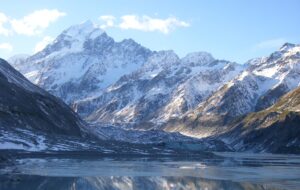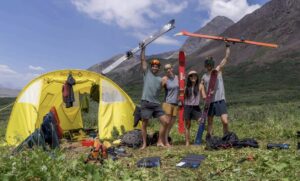In his acclaimed 1999 book, Extreme Alpinism: Climbing Light, Fast and High, American climber Mark Twight writes about advanced techniques for lightning ascents. Twight answers technical questions but also addresses strength, psychological training, nutrition, equipment, and above all, the commitment necessary for extreme climbs on high mountains. The book became an important reference for climbers around the world.

Mark Twight, Barry Blanchard, Ward Robinson, and Kevin Doyle in front of the Rupal Face of Nanga Parbat, 1988. Photo: Hank VanWeelden
Last year, trail runner Kilian Jornet asked elite climber and mountain guide Steve House how he would explain that fast and light philosophy in one sentence:
“Up and down the mountain, 100% reliant on (nearly) continuous movement for survival, security, and success,” House said. Then he added: “I will admit that I also very much enjoy climbing more slowly, with bivouacs. I like living on the mountain for many days…but I do feel that this is more dangerous, by nature, because you are exposed to the objective risk of storms for much longer.”

Steve House. Photo: Kilian Jornet
Flash climbs in alpine style are not possible for everyone. But improved technology and logistics have made flash climbing more accessible. Most people who go to the Himalaya or Karakorum just want a chance to climb a major peak, usually with an outfitter. Increasingly, the mountain community has debated how outfitters and their clients can co-exist with independent alpinists.
We should be careful when we judge guided expeditions. As Reinhold Messner has said, ”The style of each person climbing a mountain is something personal and there are no rules.” This is quite different from the old purist British style of the 1920s when, so it was said, “Only rotters use oxygen.”
How do outfitters approach speed?
Outfitting is a big business in the Himalaya. Agencies offer a variety of peaks each season and there are always plenty of clients, from project climbers who want to ascend all the 14×8,000’ers to one-off climbers who just want to experience one of the world’s highest mountains. Most of the time, the goal is Everest. But this has slowly changed in recent years. Commercial expeditions are now present on other mountains too: Manaslu, Dhaulagiri, Kangchenjunga, and K2, among others.
When a peak ceases to be newsworthy, sponsors and clients lose interest, and outfitters switch to more marketable peaks. Once guided climbs become run-of-the-mill on the great mountains, inevitably, even winter-guided expeditions will be available.
It is interesting how the duration of outfitted expeditions has changed over the years. Speed became the most important characteristic, together with better technology and security. Together, they hav led to more consistent success. Speed became a focus, not only during the ascent but throughout the expedition, from acclimatization to time in Base Camp.
Partly, this has to do with House’s reiteration of the old climbing wisdom that speed minimizes danger. Partly, it may also appeal to the sort of client who can afford these full service trips — someone with more money than time.

Kristin Harila. Photo: Kristin Harila
Speed worked on K2 last winter
But spending less time on the mountain can have drawbacks. One recent example is the K2 winter expedition organized by Seven Summit Treks. Climbers arrived at Base Camp in late December 2020. By February 9, they had left the mountain. Dawa Sherpa, the leader of Seven Summit Treks, wrote on his Instagram:
“Due to the continuous bad weather forecast [for a] further seven days…our expedition is off and we all are returning from Base Camp toward Skardu.”
One client, Tamara Lunger, had been expecting another summit push. ”I was convinced that a four-day weather window should come at some time that would allow this, but they laughed, telling me that there wasn’t. They have always come up with the statistics but didn’t take note that this year the winter was not going according to the usual scenario. Dawa said ‘the wind comes in February and that’s when the climbing time ends.’ Then when we were in Skardu, between February 14 and 18, there were four completely windless days like never before. But by then, we had all retired,” she told journalist Laszlo Pinter in April.

Tamara Lunger reluctantly leaves K2 Base Camp. Photo: Tamara Lunger
Outfitted expeditions on Annapurna and later Dhaulagiri followed those on K2. There were climbers who purchased a package for three different 8,000m peaks and participated in all three climbs.
Events on Annapurna unfolded similarly. Teams arrived at Base Camp in the last week of March, made very quick rotations, and then an early summit push, almost alongside the route fixers. When fixing Sherpas realized that they had run out of rope, a helicopter lifted O2 and more rope to Camp 3. Thanks to this intervention, the huge number of clients who were waiting on the mountain could continue to the top on April 16. It was crazy: Within three weeks, almost 70 people had climbed one of the most dangerous mountains.
As soon as Annapurna was finished, Dhaulagiri started. Climbers arrived at Base Camp on April 28, only for COVID to derail everything.
These were speed, or flash, expeditions. But that does not mean they were moving fast, light, and high. In this case, flash expeditions mean more expeditions for the agency. It means more money, more satisfied clients, more employment for Sherpas, and more bottled O2, helicopters, and permits. For outfitters, flash expeditions are three to four-week affairs, unlike the old commercial expeditions that took two months.
Commercial expeditions: the key elements
Bottled oxygen, technology, helicopters, and well-organized logistics are the backbone of commercial expeditions.
Bottled oxygen
Most client climbers need supplementary oxygen. Oxygen provides security; climbers move faster, summit sooner, and descend earlier. This speed limits risk from weather changes, avalanches, and rockfall. Furtenbach Adventures recently introduced a new model of O2 bottle and regulator, grandly announcing on their website: “You are used to nothing but success. And we want it to stay that way, even on the highest summits of our planet. To achieve this, we invest in the very latest scientific, medical, and technological developments of our time, revolutionizing high-altitude mountaineering and setting new standards.”

Photo: Lukas Furtenbach
Furtenbach offers its climbers O2 cylinders with a flow rate of eight liters per minute. Previously, four liters per minute has been the standard. The cylinders even weigh less. Imagine the difference from Irvine and Mallory’s O2 bottles in 1924, where each cylinder weighed 14 kilograms, the O2 flow rate was two liters per minute, and they needed to carry two bottles for eight hours of climbing. Now, for eight hours, climbers can use one O2 bottle which only weighs three kilograms.

Mallory, left, and Irvine used oxygen on Everest in 1924.
Technology
Base Camp personnel can now monitor in real-time the medical condition of climbers on the mountain. A sensor measures the oxygen saturation of the blood and transmits the reading to BC. If the oxygen saturation drops too far, BC informs the Sherpa accompanying the climber. He then opens the client’s regulator, increasing the flow of O2.

Photo: Lukas Furtenbach
Hypoxic systems can also provide pre-acclimatization for the client at home. These sleeping tents simulate oxygen levels of up to 7,000m. Furtenbach thinks it is very important because the clients can then spend less time exposed to dangers on the mountain. This is especially important on Everest, where multiple acclimatization rotations involve moving through the dangerous Khumbu Icefall.

Hypoxic tent. Photo: Lukas Furtenbach
This is not new to alpinism. As Sebastian Alvaro, creator and director of the acclaimed documentary series Al filo de lo impossible said, “[French climber] Patrick Berhault used a hypoxic system too, for his Shishapangma climb in 1988. It might have worked really well because he made a really fast ascent. He was among the first climbers to pre-acclimatize at home. It is curious now, in his biography, that this fact does not appear.”

Patrick Berhault. Photo: Alamy
The new hypoxic systems are more advanced and it is not necessary to go to a hospital. You can do it from home. Furtenbach has seen results: “In 2018, we were the first operator to reach the summit in less than three weeks from home, with all members pre-acclimatized using a hypoxic system.”
Helicopters
Outfitters have been using helicopters for a long time. Hundreds of helicopters fly over the Everest trekking route from Namche Bazaar to Base Camp. They carry equipment like ropes, O2, food, and gas. Sometimes they deliver to Camp 2, and occasionally even to Camp 3.
One climber posted a video last season that appeared to show clients flying from Base Camp directly to Camp 2. On Annapurna, a helicopter rectified a logistics failure, transporting extra rope to the route fixers. If there had not been a helicopter, there may not have been summits, as the weather was deteriorating.
The use of helicopters on Annapurna attracted much debate. Speaking to the El Pais newspaper, climber David Goettler laid out his position: “Media criticized the helicopter flights with climbers and equipment to Camp 2, as if it was sacrilege, but I defend it. They should fly more, carry all the material such as tents, oxygen, ropes, etc, so that the Sherpas do not have to lose their lives bringing it over the Khumbu Icefall.”

Photo: Nepal Helicopters Service






